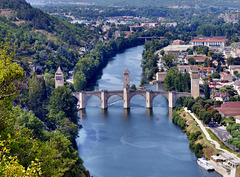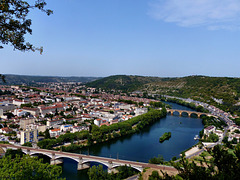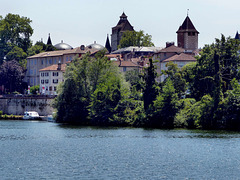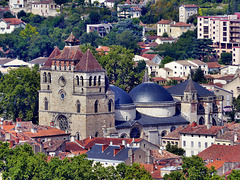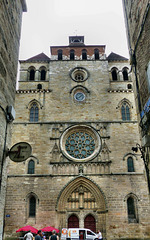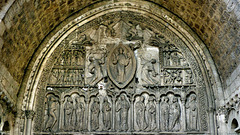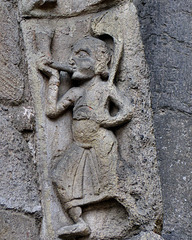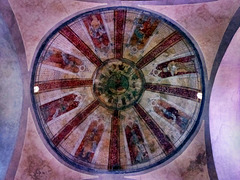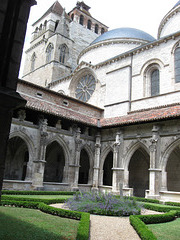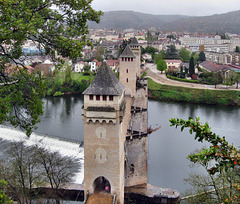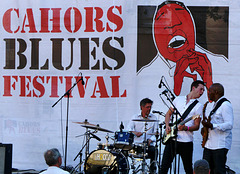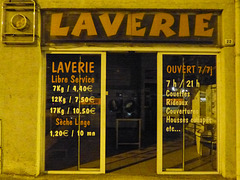
Lot (46) and Tarn-et-Garonne (82)
Photos taken over years in the departements Lot and Tarn-et-Garonne.
Cahors - Pont Valentré
| |
|
|
|
Cahors is situated within a U-shaped bend in the River Lot. There was a celtic settlement here, that developed into a large Roman city.
The city was under Visigothic later Merovingian/Frankish influence. The war between Chlothar I sons Chilperic I and Guntram (aka "Saint Guntram) badly affected the economy, but Cahors recovered - before it got burnt down and looted by Saracens, Vikings and Magyars in the 8th and 9th century.
When more and more pilgrims flocked on the way to Santiago de Compostela Cahors won importance, as the Via Podiensis run right through the city. It actually still does!
There are actually two different routes to Cahors for the pilgrims. They either can follow the valley of the Lot or they choose the "chemin" through the valley of the Cele (what I did some years ago). But there is only one chemin out of Cahors - via the Pont Valentré.
The six-span fortified bridge has become a symbol of the city. It was built between 1308 and 1378.
Cahors
| |
|
|
Cahors is situated within a U-shaped bend in the River Lot. There was a celtic settlement here, that developed into a large Roman city.
The city was under Visigothic later Merovingian/Frankish influence. The war between Chlothar I sons Chilperic I and Guntram (aka "Saint Guntram) badly affected the economy, but Cahors recovered before it got burnt down and looted by Saracens, Vikings and Magyars in the 8th and 9th century.
When more and more pilgrims flocked on the way to Santiago de Compostela Cahors won importance, as the Via Podiensis run right through the city. It actually still does!
Pope John XXII, who was born in Cahors, founded a university here in 1332, that later became a part of the University of Toulouse.
Cahors - Cathédrale Saint-Étienne
| |
|
The Cahors Cathedral was erected between 1080 and1135. It got consecrated by Pope Calixtus II in 1119. The same pope, who two years later could imprison his rival "Antipope" Gregory VIII. Four years later, Calixtus ended the Investiture Controversy by agreeing with Emperor Henry V on the Concordat of Worms.
The Cathédrale Saint-Étienne´s most prominent feature are the two domes, seen here from the banks of the River Lot. These two massive, 32 m-high, domes are huge!
During the times of medieval pilgrimage this cathedral was an important place on the "Via Podiensis", as the "Sainte Coiffe" could be venerated here. This "Holy Headdress" was believed to have been used during Jesus' burial. It had been given to Aymatus, Bishop of Cahors, by Charlemagne. A relic similar to the "Shroud of Turin".
The tower to the right is not part of the cathedral, but belongs to Cahor´s medieval fortification.
Cahors - Cathédrale Saint-Étienne
| |
|
|
|
The Cahors Cathedral was erected between 1080 and1135. It got consecrated by Pope Calixtus II in 1119. The same pope, who two years later could imprison his rival "Antipope" Gregory VIII. Four years later, Calixtus ended the Investiture Controversy by agreeing with Emperor Henry V on the Concordat of Worms.
Seen from "Croix Magne" are the Cathédrale Saint-Étienne´s domes, the most prominent features. These massive, 32 m-high, domes are huge! There was even a third one, that collapsed in the 13th century. This dome was, where the rectangular Gothic choir (1280) is now. The cathedral´s castle-like, west-facing entrance section/bell- tower was added end of the 13th / early 14th century.
During the times of medieval pilgrimage this cathedral was an important place on the "Via Podiensis", as the "Sainte Coiffe" could be venerated here. This "Holy Headdress" was believed to have been used during Jesus' burial. It had been given to Aymatus, Bishop of Cahors, by Charlemagne. A relic similar to the "Shroud of Turin".
Cahors - Cathédrale Saint-Étienne
| |
|
The Cahors Cathedral was erected between 1080 and1135. It got consecrated by Pope Calixtus II in 1119. The same pope, who two years later could imprison his rival "Antipope" Gregory VIII. Four years later, Calixtus ended the Investiture Controversy by agreeing with Emperor Henry V on the Concordat of Worms.
The most prominent features are probably the two domes (a third one collapsed in the 13th century). The cathedral´s castle-like, west-facing entrance section / bell-tower was added end of the 13th / early 14th century. It is very much like a massive Carolongian/Ottonina westwork. The rose-window makes clear, that this is younger.
During the times of medieval pilgrimage this cathedral was an important place on the "Via Podiensis", as the "Sainte Coiffe" could be venerated here. This "Holy Headdress" was believed to have been used during Jesus' burial. It had been given to Aymatus, Bishop of Cahors, by Charlemagne. A relic similar to the "Shroud of Turin".
Cahors - Cathédrale Saint-Étienne
| |
|
|
The Cahors Cathedral was erected between 1080 and 1135. It got consecrated by Pope Calixtus II in 1119. The same pope, who two years later could imprison his rival "Antipope" Gregory VIII. Four years later, Calixtus ended the Investiture Controversy by agreeing with Emperor Henry V on the Concordat of Worms.
During the times of medieval pilgrimage this cathedral was an important place on the "Via Podiensis", as the "Sainte Coiffe" could be venerated here. This "Holy Headdress" was believed to have been used during Jesus' burial. It had been given to Aymatus, Bishop of Cahors, by Charlemagne. A relic similar to the "Shroud of Turin".
On the northern side of the cathedral, this intricate Romanesque portal faces the "Via Podiensis". This was what the pilgrims saw first - and this portal they used entering the basilica.
Cahors - Cathédrale Saint-Étienne
| |
|
|
The Cahors Cathedral was erected between 1080 and 1135. It got consecrated by Pope Calixtus II in 1119. The same pope, who two years later could imprison his rival "Antipope" Gregory VIII. Four years later, Calixtus ended the Investiture Controversy by agreeing with Emperor Henry V on the Concordat of Worms.
During the times of medieval pilgrimage this cathedral was an important place on the "Via Podiensis", as the "Sainte Coiffe" could be venerated here. This "Holy Headdress" was believed to have been used during Jesus' burial. It had been given to Aymatus, Bishop of Cahors, by Charlemagne. A relic similar to the "Shroud of Turin".
On the northern side of the cathedral, this intricate Romanesque portal faces the "Via Podiensis". This was what the pilgrims saw first - and this portal they used entering the basilica. Christ in a mandorla, surrounded by angles- Below are Mary and the Apostles. The carvings are already soft and elegant. They are dated to 1130/1140.
Cahors - Cathédrale Saint-Étienne
| |
|
|
The Cahors Cathedral was erected between 1080 and 1135. It got consecrated by Pope Calixtus II in 1119. The same pope, who two years later could imprison his rival "Antipope" Gregory VIII. Four years later, Calixtus ended the Investiture Controversy by agreeing with Emperor Henry V on the Concordat of Worms.
During the times of medieval pilgrimage this cathedral was an important place on the "Via Podiensis", as the "Sainte Coiffe" could be venerated here. This "Holy Headdress" was believed to have been used during Jesus' burial. It had been given to Aymatus, Bishop of Cahors, by Charlemagne. A relic similar to the "Shroud of Turin".
On the northern side of the cathedral and intricate Romanesque portal faces the "Via Podiensis". This was what the pilgrims saw first - and this portal they used entering the basilica. The carvings are very soft and elegant. The tympanum depicts Christ in a mandorla, surrounded by angles. Very interesting are the archivolts. One of them is populated with hunters and craftsmen.
Here is a farrier shoeing a horse.
Farriers are highly esteemed artisans since about 2000 years. "The Worshipful Company of Farriers" exists in London since 1356.
www.wcf.org.uk
The scene is in deed vertically - I made it horizontally...
Cahors - Cathédrale Saint-Étienne
| |
|
|
consecrated by Pope Calixtus II in 1119. The same pope, who two years later could imprison his rival "Antipope" Gregory VIII. Four years later, Calixtus ended the Investiture Controversy by agreeing with Emperor Henry V on the Concordat of Worms.
During the times of medieval pilgrimage this cathedral was an important place on the "Via Podiensis", as the "Sainte Coiffe" could be venerated here. This "Holy Headdress" was believed to have been used during Jesus' burial. It had been given to Aymatus, Bishop of Cahors, by Charlemagne. A relic similar to the "Shroud of Turin".
On the northern side of the cathedral and intricate Romanesque portal faces the "Via Podiensis". This was what the pilgrims saw first - and this portal they used entering the basilica. The carvings are very soft and elegant. The tympanum depicts Christ in a mandorla, surrounded by angles. Very interesting are the archivolts. One of them is populated with hunters and craftsmen.
A helper at a battue. His task is, to scare the animals by blowing the horn and beating sticks into an ambush.
Cahors - Cathédrale Saint-Étienne
| |
|
|
The Cahors Cathedral was erected between 1080 and 1135. It got consecrated by Pope Calixtus II in 1119. The same pope, who two years later could imprison his rival "Antipope" Gregory VIII. Four years later, Calixtus ended the Investiture Controversy by agreeing with Emperor Henry V on the Concordat of Worms.
During the times of medieval pilgrimage this cathedral was an important place on the "Via Podiensis", as the "Sainte Coiffe" could be venerated here. This "Holy Headdress" was believed to have been used during Jesus' burial. It had been given to Aymatus, Bishop of Cahors, by Charlemagne. A relic similar to the "Shroud of Turin".
The most prominent features are probably the two domes. A third one collapsed in the 13th century, where the rectangular Gothic chor is now. Here the domes are partly seen from the nave.
Cahors - Cathédrale Saint-Étienne
| |
|
|
The Cahors Cathedral was erected between 1080 and 1135. It got consecrated by Pope Calixtus II in 1119. The same pope, who two years later could imprison his rival "Antipope" Gregory VIII. Four years later, Calixtus ended the Investiture Controversy by agreeing with Emperor Henry V on the Concordat of Worms.
During the times of medieval pilgrimage this cathedral was an important place on the "Via Podiensis", as the "Sainte Coiffe" could be venerated here. This "Holy Headdress" was believed to have been used during Jesus' burial. It had been given to Aymatus, Bishop of Cahors, by Charlemagne. A relic similar to the "Shroud of Turin".
The most prominent features are probably the two domes. Both domes had (15th c.) frescoes, but only here they could get restored after centuries of neglect.
Cahors - Cathédrale Saint-Étienne
| |
|
|
The Cahors Cathedral was erected between 1080 and 1135. It got consecrated by Pope Calixtus II in 1119. The same pope, who two years later could imprison his rival "Antipope" Gregory VIII. Four years later, Calixtus ended the Investiture Controversy by agreeing with Emperor Henry V on the Concordat of Worms.
During the times of medieval pilgrimage this cathedral was an important place on the "Via Podiensis", as the "Sainte Coiffe" could be venerated here. This "Holy Headdress" was believed to have been used during Jesus' burial. It had been given to Aymatus, Bishop of Cahors, by Charlemagne. A relic similar to the "Shroud of Turin".
The most prominent features are probably the two domes, seen here fro the cloister, that was added in 1504. While inside the cathedral all carvings got vandalized by iconoclastic fanatics during the Wars of Religion, the carvings here got spared out.
Cahors - Cathédrale Saint-Étienne
| |
|
The Cahors Cathedral was erected between 1080 and 1135. It got consecrated by Pope Calixtus II in 1119. The same pope, who two years later could imprison his rival "Antipope" Gregory VIII. Four years later, Calixtus ended the Investiture Controversy by agreeing with Emperor Henry V on the Concordat of Worms.
During the times of medieval pilgrimage this cathedral was an important place on the "Via Podiensis", as the "Sainte Coiffe" could be venerated here. This "Holy Headdress" was believed to have been used during Jesus' burial. It had been given to Aymatus, Bishop of Cahors, by Charlemagne. A relic similar to the "Shroud of Turin".
While inside the cathedral all carvings got vandalized by iconoclastic fanatics during the Wars of Religion, the carvings here got spared out. The most prominent features are probably the two domes, seen here fro the cloister, that was added in 1504. While inside the cathedral all carvings got vandalized by iconoclastic fanatics during the Wars of Religion, the carvings here got spared out. So this pilgrim wearing the shell on his hat survived. He receives a piece of bread from a generous person.
Cloister in Cahors
| |
|
|
.... My last day of just sitting around under an umbrella sipping strong french coffee. We passed Cahors and spent some time in the cloister of the cathedral.....
Cahors
| |
|
...it kept raining. After having crossed the Lot via the Pont Valentré, I climbed up the steepest and most slippery track sofar. Halfway up I turned around...
The valley of the Cele
| |
|
|
........From Figeac there are two trails to Cahors. One follows the river Lot and the other one the river Cele....
Cahors - Laurence Jones
| |
|
For a while Laurence Jones was a kind of "Wunderkind", he won the 2014 award for “Young Artist of the Year", and just a year later is a terrific, experienced blues-rock guitarist. Here on stage in Cahors with Miri Miettinen (drums) and Roger Inniss (bass).
The "Cahors Blues Festival" is the oldest festival of its kind in Europe. Blues musicians meet here since 1981.
Here is the sound of the afternoon:
www.youtube.com/watch?v=Fq3bs_Qt2rY
Cahors - Laverie
Jump to top
RSS feed- Latest items - Subscribe to the latest items added to this album
- ipernity © 2007-2024
- Help & Contact
|
Club news
|
About ipernity
|
History |
ipernity Club & Prices |
Guide of good conduct
Donate | Group guidelines | Privacy policy | Terms of use | Statutes | In memoria -
Facebook
Twitter

